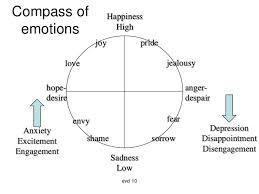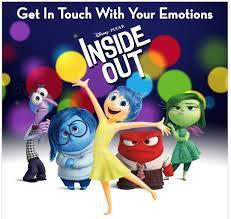This weekend I saw the new Disney Pixar movie Inside Out. I’m a big fan of Pixar already, particularly because their previous films have explored huge existential themes like death and the meaning of life, and because they often celebrate friendship and chosen families rather than the romantic relationships and biological families that so much mainstream media focuses on. That’s a big deal in a set of films that are also massively accessible and entertaining for children and adults alike.
When I saw that the main characters in Inside Out were a person’s emotions I knew that I absolutely had to go see it. I wasn’t disappointed. In fact several times I was moved to tears by how familiar the experiences were, and by this hugely important, complex, and rarely-expressed message being communicated so simply and profoundly in a ‘kid’s film’.
If you’d rather not be spoilered for the movie then please do go see it before reading the rest of this post. Also do be aware that it may well tap into lots of different emotions as you’re watching it – if you’re anything like me – not just the joyful ones. As we’ll go on to see that may not be a bad thing!
The rest of this post is divided into three sections:
- Experiencing all of our emotions
- Shutting down our emotions
- How to sit with our emotions: A practical guide
Experiencing all of our emotions
Inside Out follows an eleven-year-old, Riley, and her emotions – Joy, Sadness, Disgust, Anger and Fear – as her family moves from Minnesota to San Francisco. Previously her inner world has been dominated by Joy. Joy has made it her business to ensure that Riley remains as happy as possible, building up a store of mostly joyful memories which have, in turn, shaped her personality. However, following the house-move, many of these memories become tainted by Sadness – who can’t seem to stop herself from touching them and turning them blue.

In her attempts to prevent Sadness from causing any more damage, Joy manages to get both of them ejected from the control room to the outer reaches of Riley’s inner world. This leaves Anger, Fear and Disgust in charge while Joy and Sadness try everything they can to get back before Riley runs away from her new home.
The message of the movie is that we require all of our emotions: not just the so-called positive ones. We soon realize that Joy’s tendency to ignore and suppress Sadness is actually getting in the way of them finding their way home. It seems like things work pretty badly when just one of the emotions takes charge, and much better when they all work together through being equally valued.
One of the most poignant moments in the movie is when Riley’s old imaginary friend is devastated to realize he’s lost his last chance ever to be with Riley. Joy’s attempts to cheer him up or force him to keep going fail. However, when Sadness sits with him and shows that she understands how hard it is for him, he’s able to experience his own sadness, to cry, and eventually he’s ready to move again.
The theory that kept coming back to me as I watched the movie was Emmy Van Deurzen’s compass of emotions. In this, Van Deurzen imagines the emotions on a wheel which we travel round all of the time, moving from ‘high’ feelings like joy and pride, through anger and fear to low feelings like sadness, and then up the other side through envy and hope, to joy again.

Critically, Van Deurzen argues that we need to be able to experience all of the emotions to go around the compass like this. If there are emotions which we shut down or avoid then we’re likely to get stuck in certain places. Paradoxically, as in Inside Out, if we disallow one emotion – like sadness – we’re likely to become stuck and find that we stop experiencing joy much too. If we lose the capacity to experience some of the emotions entirely – as when Sadness and Joy are lost in the film – we risk falling into depression and all of our emotions becoming shut off. This is rightly depicted as the darkest moment in Inside Out.
It may not be that we always move in the same direction on the compass, or that certain emotions always follow others. Indeed, as Inside Out shows, we can often experience seemingly opposing emotions at the same time (e.g. joy and sadness, anger and hope, fear and determination). Indeed, when the first memory comes in that reflects these kinds of mixed feelings we see that it is perhaps even more beautiful and valuable than some of the ones which reflected only one of the basic emotions on its own.
Shutting down our emotions
The problem is that, through our lives, most of us learn that certain emotions are not acceptable: either to express or – often – even to experience.
This is what moved me to tears several times during the film as I remembered moments in my own childhood and adolescence when – like Riley – I learnt that certain feelings were unacceptable. It made it even more powerful that – for me like Riley – a critical time was the sudden experience of starting a new school with strange and different rules. However, of course, these moments are different things for different people, they happen at different points in life, and they can be gradual, or sudden, or both.
The film underlines what a terrible impact such messages can have as elements of Riley’s personality – that we’ve previously enjoyed watching – turn gray and gradually disintegrate entirely when her emotions are lost. Most devastating for me was the moment when Goofball Island disappeared. Now that it wasn’t safe for Riley to experience all of her feelings there was no way that she could goof about in the way she used to as a child.
Where does this shutting down come from? We can see it on multiple levels like those I wrote about in the recent zine that I posted about here.
On the outer level our wider culture gives us strong messages about which emotions it’s okay to feel and which it isn’t. Generally in western cultures we’re encouraged to have happiness and ‘positive’ emotions and not ‘negative’ ones. The British ‘stiff upper lip’ also discourages expressions of fear. And messages also differ depending on our individual identities, with certain emotions being seen as more or less acceptable for people of certain genders, classes, ages, or nationalities, for example.
On the next level in, our communities and institutions also reinforce many of these messages. In the movie we see how, in her new school, it isn’t acceptable either for Riley either to show too much enthusiasm for the things she’s passionate about, or to show sadness about what she’s lost. The cool girls will judge her for it. It’s easy to find ourselves joining in this kind of tone-policing in our communities – of whatever kind – whereby certain emotions are deemed unacceptable to admit to or express – for certain people or across the board. It’s worth being mindful of this whenever we find ourselves judging how somebody ‘should’ or ‘shouldn’t’ feel about something.

At the interpersonal level we learn a great deal about acceptable and unacceptable feelings from our close relationships, particularly from the family and friends who are around us growing up. In Inside Out Riley’s parents inadvertently give her the strong sense that they appreciate her being happy and strong during the house move. She takes this as a message that it isn’t okay to be struggling in any way about it. Riley is even described as their ‘happy girl’: fixing her in this way. We then see how Riley’s – and Joy’s – attempts to keep her joyful tragically have the opposite effect. By trying to sustain her joyful persona in the face of great pain she actually becomes angry, anxious and cut-off, and risks losing the love of her parents as they don’t recognize her any more. In another key moment Riley’s old friend doesn’t seem to realize how envious Riley will be of her new friendship. When envy doesn’t feel acceptable, Riley goes straight to anger, and ends the friendship.
How to sit with our emotions: A practical guide
Fortunately for Riley, Sadness and Joy are able to make it back to the control room – once Joy recognises the value of Sadness. Then Riley is able to take the risk and show her parents how sad and frightened she is. Even more fortunately, perhaps, her parents are able to accept her emotions, to share some of their own, and to let her see that they love her as much when she’s sad as they do when she’s happy.
Most of us are not so lucky. Our parents – and the other close people in our lives – live in the same wider culture as we do with all of its crappy messages about unacceptable feelings. They’re also part of institutions and communities that have done a number on them. And they’re in their own family systems wherein certain emotions have been deemed too dangerous or threatening. So they may well have responded to moments like Riley’s by giving us a clear message that our fear, sadness, anger, joy, disgust, or other feelings, were not something that they could be around, or even that they couldn’t love us if we expressed them.
We will have internalised this. Either we’ll have managed to find a way of shutting down those emotions entirely, or – perhaps – in trying to shut them down we’ll have managed to make them shout even more loudly so we’ve become defined by them. Or a bit of both. There are so many ways that this can go.
The urgent question is what we can do now. Here we are, as adults, with all these imbalances, exaggerations, and silences in our emotional states. What can we do about it?

The answer that many different therapies, meditation practices, and belief systems have come up with is the idea of ‘sitting with’ our emotions. I’ll briefly describe one of these practices – a person-centred therapy technique called focusing – here, but there are several similar practices in other therapeutic and spiritual approaches if this one doesn’t work for you.
Focusing reveals perhaps the main flaw which I found in Inside Out which is the fact that the emotions are located in Riley’s brain and not in her body. It’s good that Inside Out doesn’t buy into the popular idea that emotions and rationality are separate things. Instead it expresses the existential view that we’re always in emotion: propelled towards things or away from things by our feeling states. However, the film does buy into another ‘dualistic’ split: that of separating the mind and the body, and seeing the mind as the most important bit. Actually, this kind of focus on the mind can be part of how we lose touch with our emotions: We stop being able to tune into our bodily sensations and the important things we can learn from these about our feelings, and instead try to figure things out, or fix things, on a purely intellectual level.

In focusing practice the attention is right on these bodily states. It’s most basic form goes like this:
- Sit comfortably and quietly and bring your attention slowly to your body and how it’s feeling.
- Ask what wants your attention. Focus in on any sensation that you notice in your body (a tightness of the throat, a clenched stomach, or a sense of emptiness, for example).
- Say ‘hello’ to that sensation: welcome it warmly, like Sadness sitting down with Riley’s imaginary friend.
- Really listen to the sensation, try to find the best way to describe it (e.g. it’s like a dense ball stuck in my throat).
- Check back in with the sensation to see whether that description fits well enough, or whether you need to change it or add to it (e.g. it’s not just stuck, it’s like it’s rammed in there, like a cork in a bottle).
- Sit with the feeling, with interested curiosity, not trying to change it, or to force it to communicate: just being with it gently and curiously. Try to understand it from it’s point of view. Notice any words, images, or metaphors that come to mind. In focusing books and websites you can read about different questions that you could ask it at this point, if it feels okay to do so.
- When it feels ready to finish you can express gratitude to the feeling, and to your body, and reassure it that you’ll keep coming back to listen to it – and other feelings – in this friendly way.
Going back to Inside Out this is a lot like Riley actually giving kind attention to each of the emotions inside her whenever any of them want her attention, instead of putting one of them in charge, or trying to get rid of others. However, when we do this practice what we often find is that the feelings we become aware of are the ones that are preventing us from feeling other feelings (like Joy in the movie). You might start feeling a sensation of fear or sadness, for example, and then a strong feeling of anger or disgust at yourself for having that feeling. When we have these feelings-about-feelings the thing to do is to sit with them just as gently and curiously as with the original feeling. It can help to remind ourselves that – like Joy in Inside Out – these feelings are trying to keep us safe, even if what they are actually doing is the opposite.
Of course, given how many years most of us have spent suppressing and avoiding certain emotions, it can take a while to open up this kind of line of communication. Practices like focusing can feel very unfamiliar at first and can take a while to get the hang of. There are ways of doing them with a friend, or with a therapist, if that feels easier and more supported than doing them alone.
However I am convinced of the power of these kinds of practices. Elsewhere I wrote about what happened last year when I sat and noticed a couple of feelings that usually felt too overwhelming, or too insignificant, to sit with.
Earlier this year I went to a focusing workshop. In the first practice I found it fascinating to see how my own throat tightness shifted and opened up when I finally gave it some gentle attention. In the second practice I used focusing to go back to a specific memory when I hadn’t treated myself very kindly. sitting with the memory I suddenly became aware of a side of myself that I hadn’t seen there before: A playful side of myself that wanted to do something silly and outrageous to cut through the situation. I got a strong image of Mr. Tickle from the Mr. Men books. So much so that I went out a bought myself a Mr. Tickle mug the following week. Perhaps my own Goofball Island hasn’t been completely destroyed after all!

Find out more
You can find out more about the compass of emotions in this book and video by Emmy Van Deurzen.
A great book about the messages we receive about emotions is Transforming Emotion by Glenda Fredman.
If you want to find out more about focusing practising, The Power of Focusing by Ann Weiser Cornell is an excellent introduction to it (and nowhere near as wacky as it looks from the cover!) There are also lots of resources on The Focusing Institute and British Focusing Association websites.
Note: Some of the images in this post are Copyright (c) 2015 The Walt Disney Company and Pixar Animation Studios, to whom I express my grateful thanks.
